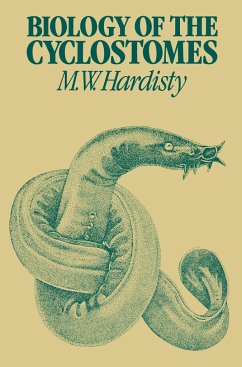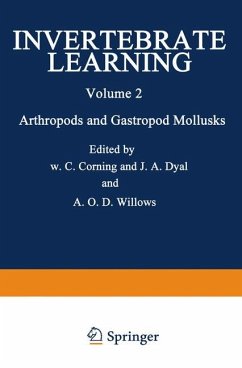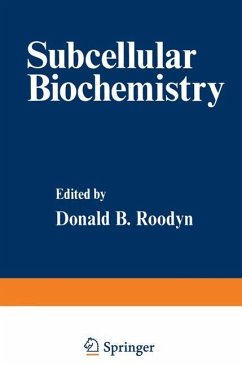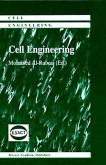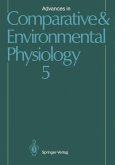- Broschiertes Buch
- Merkliste
- Auf die Merkliste
- Bewerten Bewerten
- Teilen
- Produkt teilen
- Produkterinnerung
- Produkterinnerung
The tissue culture approach to the study of membrane properties of excitable cells has progressed beyond the technical problems of culture methodology. Recent developments have fostered substantive contributions in research con cerned with the physiology, pharmacology, and biophysics of cell membranes in tissue culture. The scope of this volume is related to the application of tissue culture methodology to developmental processes and cellular mechanisms of electrical and chemical excitability. The major emphasis will be on the body of new biological information made available by the analytic…mehr
Andere Kunden interessierten sich auch für
![Biology of the Cyclostomes Biology of the Cyclostomes]() M. W. HardistyBiology of the Cyclostomes77,99 €
M. W. HardistyBiology of the Cyclostomes77,99 €![Invertebrate Learning Invertebrate Learning]() William CorningInvertebrate Learning39,99 €
William CorningInvertebrate Learning39,99 €![Subcellular Biochemistry Subcellular Biochemistry]() Subcellular Biochemistry39,99 €
Subcellular Biochemistry39,99 €![Cell Engineering Cell Engineering]() Al-RubeaiCell Engineering116,99 €
Al-RubeaiCell Engineering116,99 €![Mechanisms of Systemic Regulation Mechanisms of Systemic Regulation]() Mechanisms of Systemic Regulation74,99 €
Mechanisms of Systemic Regulation74,99 €![Advances in Comparative and Environmental Physiology Advances in Comparative and Environmental Physiology]() Advances in Comparative and Environmental Physiology77,99 €
Advances in Comparative and Environmental Physiology77,99 €![Cell Engineering Cell Engineering]() Cell Engineering110,99 €
Cell Engineering110,99 €-
-
-
The tissue culture approach to the study of membrane properties of excitable cells has progressed beyond the technical problems of culture methodology. Recent developments have fostered substantive contributions in research con cerned with the physiology, pharmacology, and biophysics of cell membranes in tissue culture. The scope of this volume is related to the application of tissue culture methodology to developmental processes and cellular mechanisms of electrical and chemical excitability. The major emphasis will be on the body of new biological information made available by the analytic possibilities inherent in the tissue culture systems. Naturally occurring preparations of excitable cells are frequently of suf ficient morphological complexity to compromise the analysis of the data obtained from them. Some of the limitations associated with dissected prepa rations have to do with the direct visualization of and access to the cell(s) in question and maintenance of steady-state conditions for prolonged periods of time. Since preparations in tissue culture can circumvent these problems, it is feasible to analyze the properties of identifiable cells, grown either singly or in prescribed geometries, as well as to follow the development of cellular inter actions. A crucial consideration in the use of cultured preparations is that they must faithfully capture the phenomenon of interest to the investigator. This and other potential limitations on the methodology are of necessary concern in the present volume.
Produktdetails
- Produktdetails
- Verlag: Springer / Springer US / Springer, Berlin
- Artikelnr. des Verlages: 978-1-4684-3805-5
- Softcover reprint of the original 1st ed. 1981
- Seitenzahl: 444
- Erscheinungstermin: 14. April 2012
- Englisch
- Abmessung: 229mm x 152mm x 24mm
- Gewicht: 639g
- ISBN-13: 9781468438055
- ISBN-10: 1468438050
- Artikelnr.: 41325829
- Verlag: Springer / Springer US / Springer, Berlin
- Artikelnr. des Verlages: 978-1-4684-3805-5
- Softcover reprint of the original 1st ed. 1981
- Seitenzahl: 444
- Erscheinungstermin: 14. April 2012
- Englisch
- Abmessung: 229mm x 152mm x 24mm
- Gewicht: 639g
- ISBN-13: 9781468438055
- ISBN-10: 1468438050
- Artikelnr.: 41325829
1 The Expression of Cholinergic and Adrenergic Properties by Autonomic Neurons in Tissue Culture.- 1. Introduction.- 2. Some Historical Aspects of the Culture of Autonomic Neurons.- 3. The Parasympathetic Neuron in Culture.- 4. Neurons of the Enteric Plexus in Culture.- 5. The Sympathetic Neuron in Culture: Basic Properties.- 5.1. Morphology.- 5.2. Biophysical Membrane Properties.- 6. Input to Sympathetic Neurons in Culture.- 6.1. Mechanisms of Neurotransmission in Vivo.- 6.2. Acetylcholine Responses of Sympathetic Neurons in Culture.- 6.3. Spinal Cord Projections to Sympathetic Neurons in Culture.- 6.4. Catecholamine Sensitivity of Sympathetic Neurons in Culture.- 6.5. The Specificity of Innervation to Sympathetic Neurons in Culture.- 7. Innervation of Visceral Target Tissues Grown with Sympathetic Neurons.- 7.1. General Aspects of the Morphology of Visceral Innervation in Vivo.- 7.2. Sympathetic Innervation in Vitro.- 8. Synaptic Interactions between Sympathetic Neurons in Culture.- 8.1. Synaptic Interactions between Sympathetic Neurons.- 8.2. Evidence That the Sympathetic Neuron "Shifts" Transmitter Production.- 8.3. The Inducing Factor for the Cholinergic Shift.- 8.4. Time Course of Inducibility.- 8.5. Two Neurotransmitters in One Cell.- 9. Discussion.- 10. Summary.- References.- 2 Electrophysiological and Structural Studies of Neurons in Dissociated Cell Cultures of the Central Nervous System.- 1. Introduction.- 2. Electrical Properties of Cultured Neurons.- 2.1. Resting Membrane Potential.- 2.2. Cell Resistance and Capacitance.- 2.3. Dendritic Characteristics.- 2.4. Action Potentials.- 3. Central Synaptic Transmission.- 3.1. Morphophysiological Aspects.- 3.2. Synaptic Mechanisms.- 3.3. Developmental Studies.- 4. General Comments.- References.- 3 Neuropharmacology of Spinal Cord Neurons in Primary Dissociated Cell Culture.- 1. Introduction.- 2. Mammalian Spinal Cord Neurons in Primary Dissociated Cell Culture.- 3. Methodology.- 3.1. Primary Dissociated Cell Cultures.- 3.2. Intracellular Recording.- 3.3. Iontophoresis and Miniperfusion.- 3.4. Perfusion.- 4. Amino Acid Pharmacology of Spinal Neurons in PDC Culture.- 5. Convulsant and Anticonvulsant Actions on Spinal Cord Neurons in PDC Culture.- 6. Summary.- 7. Future Directions.- References.- 4 Voltage Clamp Techniques Applied to Cultured Skeletal Muscle and Spinal Neurons.- 1. Introduction.- 2. Why Voltage Clamp?.- 3. Voltage Clamp System.- 4. Taming the Spinal Cord Neuron Spike.- 5. Microelectrode Shielding and Guarding.- 6. Space Clamping.- 7. Practical Points.- 7.1. General.- 7.2. Microelectrodes.- 7.3. Head Stage Amplifier.- 7.4. Gain Stage.- 7.5. Final Stage.- 7.6. Current Monitor.- References.- 5 Membrane Noise Analysis.- 1. Introduction.- 1.1. Conductance Fluctuations: A Short Historical Overview.- 2. Theory of Channel Noise.- 3. Spectra and Autocorrelation.- 4. Channel Noise.- 5. Experimental Methods for Measuring and Analyzing Conductance Fluctuations.- 5.1. Voltage Fluctuation Measurements.- 5.2. Sources of Background Noise.- 6. Current Noise under Voltage Clamp in a Microelectrode System.- 7. Measurement of Single-Channel Currents.- 7.1. Methods of Recording Single Channels from Biological Systems.- 7.2. Analysis of Noise Data.- 7.3. Applicability of Fluctuation Measurement.- 8. Summary of Major Results Obtained by Fluctuation Analysis on Chemically Excited Systems.- 8.1. Some Surprises from Noise Analysis.- 8.2. Conductance Fluctuation Studies in Tissue Culture.- References.- 6 Nerve Cells in Clonal Systems.- 1. Introduction.- 2. The C-1300 Mouse Neuroblastoma.- 2.1. Clone Isolation and Some Characteristics.- 2.2. Morphological Differentiation.- 2.3. Synapse Formation.- 2.4. Catecholamine Metabolism.- 2.5. Acetylcholine Metabolism.- 2.6. Cell Membrane.- 2.7. Specific Receptors.- 2.8. Cyclic Nucleotide Metabolism.- 2.9. Specific Proteins.- 3. Rat Pheochromocytoma.- 3.1. General Considerations.- 3.2. Morphological Differentiation Induced by NGF.- 3.3. Catecholamine Metabolism.- 3.4. Acetylcholine Metabolism.- 4. Concluding Remarks.- References.- 7 Electrophysiology of Clonal Nerve Cell Lines.- 1. Introduction.- 2. Some General Considerations about Growth and Differentiation of Clonal Nerve Cell Lines.- 3. Resting Membrane Potential.- 4. Development of Electrical Excitability.- 5. Electrical Excitability of Differentiated Neuroblastoma Cells.- 5.1. Electrical Behavior under Constant-Current Conditions.- 5.2. Voltage Clamp Experiments.- 6. Conclusions.- References.- 8 Studies of Voltage-Sensitive Sodium Channels in Cultured Cells Using Ion-Flux and Ligand-Binding Methods.- 1. Introduction.- 2. Development of Methods.- 2.1. Ion-Flux Procedures for Studies of Sodium Channels.- 2.2. Ion-Flux Procedures for Studies of Acetylcholine Receptors and Calcium Channels.- 2.3. Measurement of the Membrane Potential of Cultured Cells from the Distribution of Lipid-Soluble Ions.- 2.4. Scorpion Toxin as a Specific Radioligand for Voltage-Sensitive Sodium Channels in Excitable Cells.- 2.5. Saxitoxin as a Specific Radioligand for Voltage-Sensitive Sodium Channels in Cultured Cells.- 3. Analysis of the Properties of Voltage-Sensitive Sodium Channels in Cultured Cells Using Ion-Flux and Ligand-Binding Methods.- 3.1. Neuroblastoma Cells.- 3.2. Skeletal Muscle Cells.- 3.3. Heart Muscle Cells.- 4. Conclusion.- References.- 9 Electrophysiological Properties of Developing Skeletal Muscle Cells in Culture.- 1. Introduction.- 2. Methods and Materials.- 2.1. Cell Cultures.- 2.2. Electrophysiology.- 3. Results.- 3.1. Resting Membrane Potential.- 3.2. Ionic Mechanism of the Resting Membrane Potential.- 3.3. Passive Membrane Electrical Properties.- 3.4. Action Potentials.- 3.5. Current-Voltage Relationship.- 3.6. Acetylcholine Sensitivity.- 4. Discussion.- 4.1. Resting Membrane Potential.- 4.2. Chloride Permeability.- 4.3. Na Action Potential.- 4.4. Ca Action Potential.- 4.5. Cl Action Potential.- 4.6. Delayed Rectification.- References.- 10 The Physiology of Smooth Muscle Cells in Tissue Culture.- 1. Introduction.- 2. Methods.- 2.1. Tissue Culture.- 2.2. Acute Isolation.- 2.3. Recording Methods.- 3. Applications.- 3.1. Electrical Activity.- 3.2. Passive Electrical Properties.- 3.3. Response to Neurotransmitters.- 3.4. Innervation.- 3.5. Contraction.- 4. Conclusions.- References.- 11 Calcium Exchange in Myocardial Tissue Culture.- 1. Introduction.- 2. The Scintillation-Disk Flow Cell Technique.- 2.1. Pattern of Calcium Exchange.- 3. The Role of the Glycocalyx.- 3.1. Histochemistry.- 3.2. Sialic Acid Removal.- 4. Cation Affinity Sequence.- 5. "Gas-Dissected" Membranes.- 6. Summary.- References.- 12 Cardiac Muscle with Controlled Geometry: Application to Electrophysiological and Ion Transport Studies.- 1. Introduction.- 2. Synthetic Strand.- 2.1. Linear Electrical Properties.- 2.2. Current-Voltage Relationship and Cable Properties.- 2.3. Voltage Clamp of the Synthetic Strand.- 3. Cultured Cluster.- 3.1. Voltage Clamp of the Cultured Cluster.- 4. Polystrand.- 4.1. Morphological and Chemical Characterization.- 4.2. Potassium Flux Determination.- 4.3. Active Transport.- 5. Conclusion.- References.
1 The Expression of Cholinergic and Adrenergic Properties by Autonomic Neurons in Tissue Culture.- 1. Introduction.- 2. Some Historical Aspects of the Culture of Autonomic Neurons.- 3. The Parasympathetic Neuron in Culture.- 4. Neurons of the Enteric Plexus in Culture.- 5. The Sympathetic Neuron in Culture: Basic Properties.- 5.1. Morphology.- 5.2. Biophysical Membrane Properties.- 6. Input to Sympathetic Neurons in Culture.- 6.1. Mechanisms of Neurotransmission in Vivo.- 6.2. Acetylcholine Responses of Sympathetic Neurons in Culture.- 6.3. Spinal Cord Projections to Sympathetic Neurons in Culture.- 6.4. Catecholamine Sensitivity of Sympathetic Neurons in Culture.- 6.5. The Specificity of Innervation to Sympathetic Neurons in Culture.- 7. Innervation of Visceral Target Tissues Grown with Sympathetic Neurons.- 7.1. General Aspects of the Morphology of Visceral Innervation in Vivo.- 7.2. Sympathetic Innervation in Vitro.- 8. Synaptic Interactions between Sympathetic Neurons in Culture.- 8.1. Synaptic Interactions between Sympathetic Neurons.- 8.2. Evidence That the Sympathetic Neuron "Shifts" Transmitter Production.- 8.3. The Inducing Factor for the Cholinergic Shift.- 8.4. Time Course of Inducibility.- 8.5. Two Neurotransmitters in One Cell.- 9. Discussion.- 10. Summary.- References.- 2 Electrophysiological and Structural Studies of Neurons in Dissociated Cell Cultures of the Central Nervous System.- 1. Introduction.- 2. Electrical Properties of Cultured Neurons.- 2.1. Resting Membrane Potential.- 2.2. Cell Resistance and Capacitance.- 2.3. Dendritic Characteristics.- 2.4. Action Potentials.- 3. Central Synaptic Transmission.- 3.1. Morphophysiological Aspects.- 3.2. Synaptic Mechanisms.- 3.3. Developmental Studies.- 4. General Comments.- References.- 3 Neuropharmacology of Spinal Cord Neurons in Primary Dissociated Cell Culture.- 1. Introduction.- 2. Mammalian Spinal Cord Neurons in Primary Dissociated Cell Culture.- 3. Methodology.- 3.1. Primary Dissociated Cell Cultures.- 3.2. Intracellular Recording.- 3.3. Iontophoresis and Miniperfusion.- 3.4. Perfusion.- 4. Amino Acid Pharmacology of Spinal Neurons in PDC Culture.- 5. Convulsant and Anticonvulsant Actions on Spinal Cord Neurons in PDC Culture.- 6. Summary.- 7. Future Directions.- References.- 4 Voltage Clamp Techniques Applied to Cultured Skeletal Muscle and Spinal Neurons.- 1. Introduction.- 2. Why Voltage Clamp?.- 3. Voltage Clamp System.- 4. Taming the Spinal Cord Neuron Spike.- 5. Microelectrode Shielding and Guarding.- 6. Space Clamping.- 7. Practical Points.- 7.1. General.- 7.2. Microelectrodes.- 7.3. Head Stage Amplifier.- 7.4. Gain Stage.- 7.5. Final Stage.- 7.6. Current Monitor.- References.- 5 Membrane Noise Analysis.- 1. Introduction.- 1.1. Conductance Fluctuations: A Short Historical Overview.- 2. Theory of Channel Noise.- 3. Spectra and Autocorrelation.- 4. Channel Noise.- 5. Experimental Methods for Measuring and Analyzing Conductance Fluctuations.- 5.1. Voltage Fluctuation Measurements.- 5.2. Sources of Background Noise.- 6. Current Noise under Voltage Clamp in a Microelectrode System.- 7. Measurement of Single-Channel Currents.- 7.1. Methods of Recording Single Channels from Biological Systems.- 7.2. Analysis of Noise Data.- 7.3. Applicability of Fluctuation Measurement.- 8. Summary of Major Results Obtained by Fluctuation Analysis on Chemically Excited Systems.- 8.1. Some Surprises from Noise Analysis.- 8.2. Conductance Fluctuation Studies in Tissue Culture.- References.- 6 Nerve Cells in Clonal Systems.- 1. Introduction.- 2. The C-1300 Mouse Neuroblastoma.- 2.1. Clone Isolation and Some Characteristics.- 2.2. Morphological Differentiation.- 2.3. Synapse Formation.- 2.4. Catecholamine Metabolism.- 2.5. Acetylcholine Metabolism.- 2.6. Cell Membrane.- 2.7. Specific Receptors.- 2.8. Cyclic Nucleotide Metabolism.- 2.9. Specific Proteins.- 3. Rat Pheochromocytoma.- 3.1. General Considerations.- 3.2. Morphological Differentiation Induced by NGF.- 3.3. Catecholamine Metabolism.- 3.4. Acetylcholine Metabolism.- 4. Concluding Remarks.- References.- 7 Electrophysiology of Clonal Nerve Cell Lines.- 1. Introduction.- 2. Some General Considerations about Growth and Differentiation of Clonal Nerve Cell Lines.- 3. Resting Membrane Potential.- 4. Development of Electrical Excitability.- 5. Electrical Excitability of Differentiated Neuroblastoma Cells.- 5.1. Electrical Behavior under Constant-Current Conditions.- 5.2. Voltage Clamp Experiments.- 6. Conclusions.- References.- 8 Studies of Voltage-Sensitive Sodium Channels in Cultured Cells Using Ion-Flux and Ligand-Binding Methods.- 1. Introduction.- 2. Development of Methods.- 2.1. Ion-Flux Procedures for Studies of Sodium Channels.- 2.2. Ion-Flux Procedures for Studies of Acetylcholine Receptors and Calcium Channels.- 2.3. Measurement of the Membrane Potential of Cultured Cells from the Distribution of Lipid-Soluble Ions.- 2.4. Scorpion Toxin as a Specific Radioligand for Voltage-Sensitive Sodium Channels in Excitable Cells.- 2.5. Saxitoxin as a Specific Radioligand for Voltage-Sensitive Sodium Channels in Cultured Cells.- 3. Analysis of the Properties of Voltage-Sensitive Sodium Channels in Cultured Cells Using Ion-Flux and Ligand-Binding Methods.- 3.1. Neuroblastoma Cells.- 3.2. Skeletal Muscle Cells.- 3.3. Heart Muscle Cells.- 4. Conclusion.- References.- 9 Electrophysiological Properties of Developing Skeletal Muscle Cells in Culture.- 1. Introduction.- 2. Methods and Materials.- 2.1. Cell Cultures.- 2.2. Electrophysiology.- 3. Results.- 3.1. Resting Membrane Potential.- 3.2. Ionic Mechanism of the Resting Membrane Potential.- 3.3. Passive Membrane Electrical Properties.- 3.4. Action Potentials.- 3.5. Current-Voltage Relationship.- 3.6. Acetylcholine Sensitivity.- 4. Discussion.- 4.1. Resting Membrane Potential.- 4.2. Chloride Permeability.- 4.3. Na Action Potential.- 4.4. Ca Action Potential.- 4.5. Cl Action Potential.- 4.6. Delayed Rectification.- References.- 10 The Physiology of Smooth Muscle Cells in Tissue Culture.- 1. Introduction.- 2. Methods.- 2.1. Tissue Culture.- 2.2. Acute Isolation.- 2.3. Recording Methods.- 3. Applications.- 3.1. Electrical Activity.- 3.2. Passive Electrical Properties.- 3.3. Response to Neurotransmitters.- 3.4. Innervation.- 3.5. Contraction.- 4. Conclusions.- References.- 11 Calcium Exchange in Myocardial Tissue Culture.- 1. Introduction.- 2. The Scintillation-Disk Flow Cell Technique.- 2.1. Pattern of Calcium Exchange.- 3. The Role of the Glycocalyx.- 3.1. Histochemistry.- 3.2. Sialic Acid Removal.- 4. Cation Affinity Sequence.- 5. "Gas-Dissected" Membranes.- 6. Summary.- References.- 12 Cardiac Muscle with Controlled Geometry: Application to Electrophysiological and Ion Transport Studies.- 1. Introduction.- 2. Synthetic Strand.- 2.1. Linear Electrical Properties.- 2.2. Current-Voltage Relationship and Cable Properties.- 2.3. Voltage Clamp of the Synthetic Strand.- 3. Cultured Cluster.- 3.1. Voltage Clamp of the Cultured Cluster.- 4. Polystrand.- 4.1. Morphological and Chemical Characterization.- 4.2. Potassium Flux Determination.- 4.3. Active Transport.- 5. Conclusion.- References.


